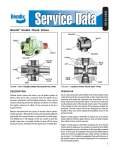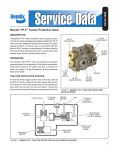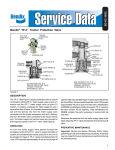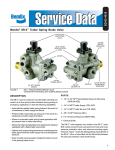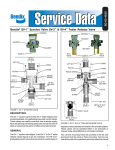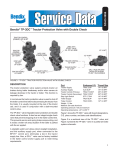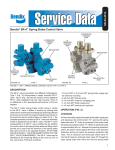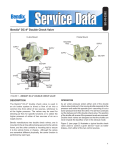Download BENDIX BW1438 User's Manual
Transcript
SD-03-3653 Bendix® TP-4™ Tractor Protection Valve (Formerly VM-1) PRIMARY CIRCUIT DELIVERY PORT (PCD) TRAILER EMERG. STOP LIGHT SWITCH (TE-SLS) PORT TRAILER EMERG. SUPPLY (TES) PORT SECONDARY CIRCUIT DELIVERY PORT (SCD) MOUNTING SURFACE VENT SERVICE STOP LIGHT SWITCH (SLS) PORT TRAILER SERVICE SUPPLY PORT (TSS) FIGURE 1 EXTERIOR VIEW 2 10 8 3 VENT 12 6 7 PIPE PLUG 5 9 4 11 13 1 16 15 14 FIGURE 2 SECTIONAL DESCRIPTION The Bendix® TP-4™ tractor protection valve is used in the dual air brake system and houses three valves that serve the trailer and tractor braking system. The valves are: 1. The trailer service line shut off portion of tractor protection system which operates in conjunction with the dash-mounted PP-3™ trailer supply valve to manually or automatically close and retain sufficient air pressure in the towing vehicle to stop it with its service brakes. 2. A double check valve which permits either primary or secondary circuit air pressure from the dual brake valve to actuate trailer brakes. 3. A double check valve which permits use of a trailer control valve to control only the trailer brakes. In addition to the ports necessary for the function of the above described valves, the manifold also provides ports for the installation of the service stop light switch, front axle limiting control valve, and the TE-1™ trailer emergency stop light switch. Four 23/64" holes are provided for mounting. 1 Each double check valve has two separate inlets and one common outlet, and the passage of air can be traced by referring to Schematic Figure 3. OPERATION TRACTOR PROTECTION VALVE PORTION Air from the delivery line of the PP-3™ trailer supply valve located within the cab enters the manifold at the tractor protection control (delivery) port and passes through the manifold, acts upon the plunger and moves the inlet valve off its seat, opening the service line passage through the manifold. If the PP-3™ trailer supply valve is manually or automatically actuated, the trailer emergency line air pressure will exhaust out the PP-3™ trailer supply valve exhaust port, causing an application of the trailer brakes. The piston spring will move the piston allowing the inlet valve spring to close the inlet valve, closing the service line passage through the manifold, and protecting tractor air pressure. DOUBLE CHECK VALVE PORTIONS There are two double check valves in the TP-4™ tractor protection valve, and they work in combination with each other to perform the following functions: 1. To permit the trailer hand control valve to be used for applying trailer service brakes only. 2. To permit either the primary or secondary circuit from the dual brake valve to apply trailer brakes if air is lost in either one of the circuits. TO FRONT BRAKE LIMITING CONTROL VALVE FROM TRAILER DOUBLE CHECK CONTROL VALVE “A” VALVE Double check valve A inlets are connected to the trailer hand control valve and the secondary delivery circuit of the dual brake valve. If the hand control valve is applied, the shuttle of the double check valve will move and seal off the secondary delivery passage from the brake valve. Air from the hand control valve will pass out the outlet port of double check valve A. See Figure 4. If a foot brake valve application is made, the shuttle of double check valve A seals off the trailer hand control valve air passage and application air will pass out the outlet port of double check valve A. Double check valve B inlets are connected to the primary delivery circuit of the dual brake valve and the outlet of double check valve A. The purpose of double check valve B is to permit actuation of trailer brakes should a loss of air occur in either the primary or secondary braking circuits of the tractor. When a foot brake application is made, air from the primary delivery circuit enters one inlet of the double check valve and air from the secondary circuit passes through double check valve A and enters the other inlet valve of double check valve B. Air passes out the outlet port and through the tractor protection valve to the trailer actuating the trailer brakes. See Figure 5. FROM PP-3™ TRAILER SUPPLY VALVE TO TRAILER EMERGENCY LINE DOUBLE CHECK VALVE “B” REAR FACE PRIMARY CIRCUIT (DELIVERY) FROM DUAL BRAKE VALVE A B C VENT TRAILER SERVICE LINE SHUT-OFF VALVE SECONDARY CIRCUIT (DELIVERY) FRONT FACE STOP LIGHT SWITCH TE-1™ TRAILER EMERGENCY STOP LIGHT SWITCH TO TRAILER SERVICE LINE FIGURE 3 TP-4™ TRACTOR PROTECTION VALVE 2 TRAILER CONTROL VALVE TRAILER SUPPLY VALVE TWO WAY VALVE PRIMARY RESERVOIR TO LIMITING AND Q.R. VALVE SECONDARY RESERVOIR DUAL BRAKE VALVE A B TO TRAILER EMERGENCY C VENT TRAILER EMERGENCY STOP-LIGHT SWITCH STOP LIGHT SWITCH TO TRAILER SERVICE FIGURE 4 TP-4™ TRACTOR PROTECTION VALVE (TRAILER APPLICATION) PREVENTIVE MAINTENANCE Important: Review the Bendix Warranty Policy before performing any intrusive maintenance procedures. A warranty may be voided if intrusive maintenance is performed during the warranty period. No two vehicles operate under identical conditions; as a result, maintenance intervals may vary. Experience is a valuable guide in determining the best maintenance interval for air brake system components. At a minimum, the TP-4™ valve should be inspected every 6 months or 1500 operating hours, whichever comes first, for proper operation. Should the TP-4™ valve not meet the elements of the operational tests noted in this document, further investigation and service of the valve may be required. SERVICE CHECKS OPERATING AND LEAKAGE CHECKS 1. With ignition switch on, place tractor protection control valve in emergency position. If vehicle is equipped with emergency stop light switch, trailer stop lights should function. 2. Charge air brake system to governor cut-out and block wheels. 3. Apply trailer hand control valve and check at open tractor service hose coupling for leakage. Excessive leakage would indicate faulty tractor protection valve inlet valve. (Item 6, Figure 2) 4. Release trailer hand control valve and place tractor protection control valve in normal position, with trailer supply hose connected to trailer supply hose coupling. 5. Connect tractor service hose coupling to a test gauge. 6. Apply trailer hand control valve and note that service air pressure is present at the service hose coupling. If service air pressure is not present, this would indicate either a faulty tractor protection valve or a faulty shuttle in one of the double check valves. Check foot brake valve exhaust for leakage. If leakage is detected, double check valve requires servicing. Release trailer hand control valve. 7. With ignition switch on, apply and hold a foot brake valve application and note that stop lights function. Check foot brake valve exhaust for leakage. If leakage is detected, double check valve requires servicing. 8. Disconnect line from primary circuit delivery (PCD) port. Plug end of line. (NOTE: Fitting and crimped copper tubing can be assembled and used as a plug. Care should be used so that there is no danger, if plug be loosened, that it be projected by air when application of foot brake valve is made.) 9. Make a foot brake valve application and check primary circuit delivery (PCD) port of manifold for leakage. Leakage at port indicates double check valve requires servicing. Remove plug from line and reconnect to manifold. 3 TRAILER CONTROL VALVE TRAILER SUPPLY VALVE TWO WAY VALVE PRIMARY RESERVOIR TO LIMITING AND Q.R. VALVE TO TRAILER EMERGENCY SECONDARY RESERVOIR DUAL BRAKE VALVE A B C VENT TRAILER EMERGENCY STOP LIGHT SWITCH STOP LIGHT SWITCH TO TRAILER SERVICE FIGURE 5 TP-4™ TRACTOR PROTECTION VALVE (SERVICE APPLICATION) 10. Disconnect line from secondary circuit delivery (SCD) port and plug end of line. Make a foot brake valve application and check secondary circuit delivery (SCD) port of valve for leakage. Leakage at port indicates double check valve requires servicing. Remove plug from line and reconnect to valve. 11. Make a foot valve application and test for gasket leakage. Tighten bolts if necessary. (See #4 “Assembly” for Proper Torque Sequence.) 4. Remove large retaining ring (13) from lower body. Remove valve retainer (14), spring (7) and inlet valve (6). Remove o-ring (5) from valve retainer. (NOTE: Older revision valves may have an o-ring (1), sealing disc (16) and small retaining ring (15) as shown in Figure 3. These need not be disturbed unless leakage was noted, in which case the retaining ring must be removed and the o-ring replaced.) If the TP-4™ tractor protection valve does not function as described above or leakage is excessive, it is recommended that it be replaced with a new or remanufactured unit, or repaired with genuine Bendix parts available at authorized Bendix parts outlets, in which case the following should prove helpful. CLEANING AND INSPECTION DISASSEMBLY 3. Inspect the bores of the valve housing for deep scuffing or gouges. 1. Remove six (6) cap screws (11) Figure 2 and lockwashers. This will permit separation of the body, intermediate body and lower body and gaskets. (9) & (10) 2. Remove piston (12) and piston spring (8) from intermediate body. Remove o-rings (2) and (3) from piston (12). 3. Remove both double check valve shuttles (4) and guides from body. 4 1. Clean all metal parts in mineral spirits and dry them completely. 2. Inspect all parts for excessive wear or deterioration. Inspect valve seats for nicks or burrs. Check the valve spring for cracks or corrosion. Replace all parts that were discarded and any parts not found to be serviceable during inspection, using only genuine Bendix replacement parts. ASSEMBLY Before assembling the TP-4™ valve, lubricate all o-rings, o-ring grooves, body bores and rubbing surfaces with Bendix silicone lubricant (Pc. No. 291126) or equivalent. NOTE: When using pipe thread sealant during assembly and installation, take particular care to prevent the sealant from entering the valve itself. Apply the sealant beginning with the second thread back from the end. 3. 1. Install inlet valve (6). Install o-ring (5) on valve retainer (14). Install spring (7) and valve retainer. Install retainer ring (13) making certain it is engaged in groove. 2. Install double check valve guides in intermediate body and install shuttles (4) in guides. 4. 3. Install spring (8) in body. Install o-rings (2) and (3) on piston (12). Insert stem of piston inside of spring, making sure vent is open. 4. Install new gaskets (9) and (10) on both sides of intermediate body (Note: locating pins match corresponding holes in gasket). Install lower and upper bodies with assembly in the following manner. 5. A. Torque center two (2) cap screws to 80" lbs. 6. B. Torque upper right and lower left cap screws to 80" lbs. 7. C. Torque lower right and upper left cap screws to 80" lbs. D. IMPORTANT - Repeat steps A, B, and C. 8. TESTING REBUILT TP-4™ VALVE Perform Operating and Leakage Tests, as outlined in “Service Checks” section. WARNING! PLEASE READ AND FOLLOW THESE INSTRUCTIONS TO AVOID PERSONAL INJURY OR DEATH: 9. engine be in operation, EXTREME CAUTION should be used to prevent personal injury resulting from contact with moving, rotating, leaking, heated or electrically charged components. Do not attempt to install, remove, disassemble or assemble a component until you have read and thoroughly understand the recommended procedures. Use only the proper tools and observe all precautions pertaining to use of those tools. If the work is being performed on the vehicle’s air brake system, or any auxiliary pressurized air systems, make certain to drain the air pressure from all reservoirs before beginning ANY work on the vehicle. If the vehicle is equipped with an AD-IS® air dryer system or a dryer reservoir module, be sure to drain the purge reservoir. Following the vehicle manufacturer’s recommended procedures, deactivate the electrical system in a manner that safely removes all electrical power from the vehicle. Never exceed manufacturer’s recommended pressures. Never connect or disconnect a hose or line containing pressure; it may whip. Never remove a component or plug unless you are certain all system pressure has been depleted. Use only genuine Bendix® replacement parts, components and kits. Replacement hardware, tubing, hose, fittings, etc. must be of equivalent size, type and strength as original equipment and be designed specifically for such applications and systems. Components with stripped threads or damaged parts should be replaced rather than repaired. Do not attempt repairs requiring machining or welding unless specifically stated and approved by the vehicle and component manufacturer. Prior to returning the vehicle to service, make certain all components and systems are restored to their proper operating condition. When working on or around a vehicle, the following general precautions should be observed at all times. 10. 1. Park the vehicle on a level surface, apply the parking brakes, and always block the wheels. Always wear safety glasses. 2. Stop the engine and remove ignition key when working under or around the vehicle. When working in the engine compartment, the engine should be shut off and the ignition key should be removed. Where circumstances require that the 11. For vehicles with Antilock Traction Control (ATC), the ATC function must be disabled (ATC indicator lamp should be ON) prior to performing any vehicle maintenance where one or more wheels on a drive axle are lifted off the ground and moving. 5 6 BW1438 © 2007 Bendix Commercial Vehicle Systems LLC. All rights reserved. 6/2007 Printed in U.S.A.






